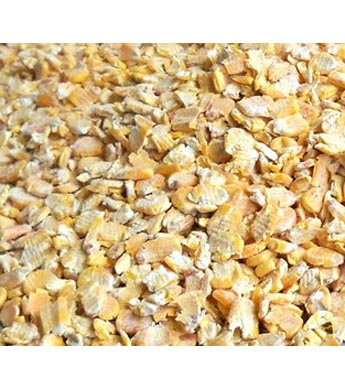Nutrition
Whole Corn vs. Cracked

Alternative Feedstuffs for Livestock
Whole corn vs. cracked. As commodity prices rise, livestock producers are on the lookout for alternative feedstuffs to get a good deal. When it comes to corn, producers can get a lot of bang for their buck. Many people want to know if there is a nutritional benefit of cracked corn when compared to whole corn.
The Impact of Grain Processing

Is there a nutritional benefit of whole corn vs. cracked? Research on the impact of grain processing on ruminant performance has been carried out for a long time, yet further studies are still being done. An overview of the research done before was published more than 25 years ago, which showed similar daily gains when corn was either whole or cracked, and intake was slightly lower, resulting in improved feed efficiency when the grain was left whole.
More recently, a study at North Dakota State University compared animal performance when feeding rations of whole corn, rolled corn, and ground corn in yearling steers. Though there was a difference in intake and feed to gain ratio, there was not a difference in rate of gain or carcass quality. In short, there are only small differences in performance when feeding milled versus whole corn.
There are only small differences in performance when feeding milled vs whole corn
North Dakota State University
Risk of Rumen Starch Digestion
The rumen and whole corn vs. cracked corn. When feeding corn to rumen animals, the main site of starch digestion is the rumen and processing can affect the degree of digestion. Processing can increase rumen starch digestion from around 60% to 80%, but this can also lead to ruminal acidosis and digestive disturbances. To reduce these risks, it is important to provide sufficient forage intake, and substituting low starch feedstuffs such as corn gluten and distillers grains for corn or other grains can help.
Providing grain that is too finely ground can result in acidosis. When finely ground, high-starch feeds go into the rumen, the are broken down quickly and cause a drop in pH. It is important to avoid this drop in pH by providing adequate roughage in the diet, and not milling corn to a fine powder. Click HERE to learn more about the rumen and how it functions.
Conclusion

Is there a nutritional benefit of cracked corn when compared to whole corn? Ohio researchers showed that the percentage of whole corn kernels digested was the same at 92%, regardless of grain processing. When around 500-700 feeders were offered a receiving diet containing 35% forage, gains were slightly higher for whole corn compared to cracked and the feed efficiency was similar. These findings, along with the results from the North Dakota State University study, suggest that there is little or no benefit to processing corn.
In our area, cracked or ground corn is often much more expensive than whole corn. As such, the cost of processing corn may not be recovered unless finishing cattle are given low-roughage diets. Therefore, when considering what to feed sheep, goats, and cattle, producers should take all of the above into account. Don’t forget to check out our other blogs HERE!

